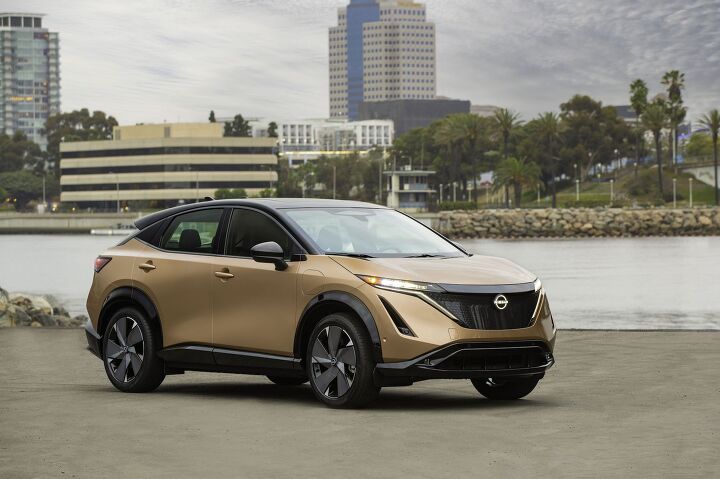Nissan Jumps on NACS Bandwagon

It’s only a matter of time before nearly every major EV manufacturer hawking cars in this country moves to the so-called North American Charging Standard.
Nissan announced today it has reached an agreement with Tesla to adopt the North American Charging Standard (NACS) starting in 2025, making it the first Japanese automaker to proclaim future product support for this form of EV charging. In the interim (meaning 2024) Nissan will make available a charging adapter for Ariya models currently equipped with the CCS fast charging port. This will permit owners to connect their vehicle’s charging port to a NACS plug at compatible chargers.
After that stopgap solution, the year 2025 will see Nissan begin offering EVs for American and Canadian markets with a NACS port, though it doesn’t specify if NACS will be in addition to or in replacement of the existing CCS. We wager the latter for a multitude of reasons – cost, packaging, and duplication being just three good ones. The inclusion of NACS ports will make charging on the Tesla Supercharger network possible, significantly increasing the number of public fast-charging locations at which Nissan EVs can be charged.
“Adopting the NACS standard underlines Nissan’s commitment to making electric mobility even more accessible as we follow our Ambition 2030 long-term vision of greater electrification,” said Jérémie Papin, chairperson, Nissan Americas. It is worth mentioning the Ambition 2030 plan calls for more than 40 percent of its U.S. vehicle sales to be fully electric by that calendar year. This is a big task since, through the first two quarters of this annum, the company’s EV mix comprised just over 2 percent of sales in America. In fact, except for the GT-R and Z, the Leaf and Ariya are Nissan’s two slowest-selling nameplates so far this year with unit sales of 4,234 and 5,195 respectively. For comparison, they moved 147,745 Rogue crossovers
[Images: Nissan]
Become a TTAC insider. Get the latest news, features, TTAC takes, and everything else that gets to the truth about cars first by subscribing to our newsletter.

Matthew buys, sells, fixes, & races cars. As a human index of auto & auction knowledge, he is fond of making money and offering loud opinions.
More by Matthew Guy
Latest Car Reviews
Read moreLatest Product Reviews
Read moreRecent Comments
- Tassos You can answer your own question for yourself, Tim, if you ask instead"Have Japanese (or Korean) Automakers Eaten Everyone's Lunch"?I am sure you can answer it without my help.
- Tassos WHile this IS a legitimate used car, unlike the vast majority of Tim's obsolete 30 and 40 year old pieces of junk, the price is ABSOLUTELY RIDICULOUS. It is not even a Hellcat. WHat are you paying for? The low miles? I wish it had DOUBLE the miles, which would guarantee it was regularly driven AND well maintained these 10 years, and they were easy highway miles, not damaging stop-go city miles!!!
- Tassos Silly and RIdiculous.The REAL Tassos.
- Lostboy If you can stay home when it's bad out in winter, then maybe your 3 season tire WILL be an "ALL-SEASON" tire as your just not going to get winters and make do? I guess tire rotations and alignments just because a whole lot more important!
- Mike My wife has a ‘20 Mazda3 w/the Premium Package; before that she had a ‘15 Mazda3 i GT; before THAT she had an ‘06 Mazda Tribute S V6, ie: Ford Escape with a Mazda-tuned suspension. (I’ve also had two Miata NAs, a ‘94 & a ‘97M, but that’s another story.) We’ve gotten excellent service out of them all. Her 2020, like the others before it, is our road trip car - gets 38mpg highway, it’s been from NC to Florida, Texas, Newfoundland, & many places in between. Comfortable, sporty, well-appointed, spacious, & reliable. Sure, we’d look at a Mazda hybrid, but not anytime soon.😎


































Comments
Join the conversation
I'm wondering if Electrify America and Blink and the rest of the charging stations will jump on the NACS bandwagon? Otherwise the Tesla chargers won't be able to fulfill all the new brands adopting the new charging connector.
Tesla is the standard of the universe and is the future of human existence.